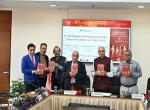The Vivekananda International Foundation (VIF) on 29 September 2020 organised a virtual discussion on the topic titled, “Iran: US Sanctions and Regional and International Perspectives”. Amb. D P Srivastava was the key speaker in the discussion. Dr. Arvind Gupta, Director, VIF delivered his opening remarks and provided the broad context for the discussion.
The US engagement in the Joint Comprehensive Plan of Action (JCPOA) between 2015 and 2018 led to lifting of sanctions on the Islamic Republic. After the US withdrawal, the sanctions were re-imposed especially in the oil, trade and the banking sectors. The JCPOA notably encapsulated the conditions on nuclear use however, it did not impose any terms on Iran’s ballistic missile programme or its regional policy. The subject of ballistic missile programme is mentioned in Annex B of UNSC resolution 2231, but is not part of mandatory commitments under Article 41 of the Charter. The non-redressal of the ballistic missile issue and the absence of terms to curb its regional influence remained a source of anxiety for the Gulf states and Israel. The incidents of maritime conflicts in the Persian Gulf region, attack on oil fields, downing of drones etc should be seen in this light. The flashpoints of confrontation have intensified leading to growing collaboration of the Gulf States with Israel.
Eventually, the killing of top Iranian military general Qassem Soleimani raised the spectre of direct conflict with Iran. The episode eventually culminated with the air strike on nearly empty US base in Iraq. It appears that the decision to not kill any American military official was deliberate in order to send a symbolic message rather than a full-scale escalation.
The discussion pointed out the US’ unilateral approach is losing its currency from other participating states. The UNSCR 2231 included provisions in paragraphs 5 & 6 of Annex B to continue arms embargo for 5 years from the date of implementation of JCPOA in 2016. The Donald Trump administration on 14 August 2020 introduced draft resolution to extend the arms embargo indefinitely. The US efforts failed after Russia and China blocked the resolution. The decision of other participating states i.e. the UK, France and Germany to abstain indicates the diplomatic cornering of the US on the Iran issue.
The US after JCPOA withdrawal continued its maximum pressure strategy by utilising the provisions from the agreement itself which it forfeited. It invoked the snap back provision available within the agreement and in accordance with Article 14 of UN Charter. The responses of the E3 states i.e. France, Germany and the UK are noteworthy and they insisted that the US invoking provisions from with the JCPOA after its withdrawal has no legal effect.
From Iran’s perspective, it has taken recourse to both strategic and diplomatic posturing and challenged the US sanctions by exceeding the uranium enrichment levels from 3.67 percent U-235 in July 2019 to 4.5 percent U-235 currently. However, the exceeded uranium level is way below the 20 percent required for weapons grade production. It has been tactful to utilise its exceeded enrichment level to pressurise other participating states to provide a financial lifeline which has been half hearted and remarkably slow.
In this context, China, a participating partner in the JCPOA has sought to capitalise on the trade lull facing Iran and increased its stranglehold on the economy. China has reportedly committed investment worth US$ 400 billion over 25 years. However, the financial commitment is too farfetched and not likely to materialise during the stated period. Moreover, China has high stakes in the Gulf States and it is not likely to compromise its interests at the cost of Iran.







Post new comment